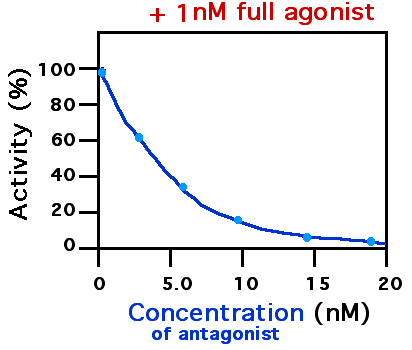|
Orvepitant
Orvepitant (GW823296) is a drug developed by GlaxoSmithKline which acts as a selective antagonist for the NK1 receptor. It was under development as a potential antidepressant drug, and early stage human clinical trials showed it to have some antidepressant effects, though not with sufficient efficacy to justify further development for this application. It was however considered a successful proof of concept A proof of concept (POC or PoC), also known as proof of principle, is an inchoate realization of a certain idea or method in order to demonstrate its feasibility or viability. A proof of concept is usually small and may or may not be complete ... for NK1 antagonists as potential antidepressants, and efforts are continuing to find more potent compounds which might be more effective. References NK1 receptor antagonists Trifluoromethyl compounds Fluoroarenes {{nervous-system-drug-stub ... [...More Info...] [...Related Items...] OR: [Wikipedia] [Google] [Baidu] |
GlaxoSmithKline
GSK plc (an acronym from its former name GlaxoSmithKline plc) is a British Multinational corporation, multinational Pharmaceutics, pharmaceutical and biotechnology company with headquarters in London. It was established in 2000 by a Mergers and acquisitions, merger of Glaxo Wellcome and SmithKline Beecham, which was itself a merger of a number of pharmaceutical companies around the Smith, Kline & French firm. GSK is the tenth largest pharmaceutical company and No. 294 on the 2022 Fortune Global 500, ''Fortune'' Global 500, ranked behind other pharmaceutical companies China Resources, Sinopharm (company), Sinopharm, Johnson & Johnson, Pfizer, Roche, AbbVie, Novartis, Bayer, and Merck & Co., Merck Sharp & Dohme. The company has a primary listing on the London Stock Exchange and is a constituent of the FTSE 100 Index. As of February 2024, it had a Market capitalization, market capitalisation of £69 billion, the eighth largest on the London Stock Exchange. The company developed ... [...More Info...] [...Related Items...] OR: [Wikipedia] [Google] [Baidu] |
Antagonist (pharmacology)
A receptor antagonist is a type of receptor ligand or drug that blocks or dampens a biological response by binding to and blocking a receptor rather than activating it like an agonist. Antagonist drugs interfere in the natural operation of receptor proteins.Pharmacology Guide: In vitro pharmacology: concentration-response curves ." '' GlaxoWellcome.'' Retrieved on December 6, 2007. They are sometimes called blockers; examples include s, |
Tachykinin Receptor 1
The tachykinin receptor 1 (TACR1) also known as neurokinin 1 receptor (NK1R) or substance P receptor (SPR) is a G protein coupled receptor found in the central nervous system and peripheral nervous system. The endogenous ligand for this receptor is Substance P, although it has some affinity for other tachykinins. The protein is the product of the ''TACR1'' gene. Structure Tachykinins are a family of neuropeptides that share the same hydrophobic C-terminal region with the amino acid sequence Phe-X- Gly- Leu- Met-NH2, where X represents a hydrophobic residue that is either an aromatic or a beta-branched aliphatic. The N-terminal region varies between different tachykinins. The term tachykinin originates in the rapid onset of action caused by the peptides in smooth muscles. Substance P (SP) is the most researched and potent member of the tachykinin family. It is an undecapeptide with the amino acid sequence Arg-Pro- Lys-Pro- Gln- Gln- Phe- Phe- Gly- Leu- Met-NH2. SP binds to a ... [...More Info...] [...Related Items...] OR: [Wikipedia] [Google] [Baidu] |
Receptor (biochemistry)
In biochemistry and pharmacology, receptors are chemical structures, composed of protein, that receive and Signal_transduction, transduce signals that may be integrated into biological systems. These signals are typically chemical messengers which bind to a receptor and produce physiological responses, such as a change in the electrophysiology, electrical activity of a cell. For example, GABA, an inhibitory neurotransmitter, inhibits electrical activity of neurons by binding to GABAA receptor, GABA receptors. There are three main ways the action of the receptor can be classified: relay of signal, amplification, or integration. Relaying sends the signal onward, amplification increases the effect of a single ligand (biochemistry), ligand, and integration allows the signal to be incorporated into another biochemical pathway. Receptor proteins can be classified by their location. Cell surface receptors, also known as transmembrane receptors, include ligand-gated ion channels, G prote ... [...More Info...] [...Related Items...] OR: [Wikipedia] [Google] [Baidu] |
Antidepressant
Antidepressants are a class of medications used to treat major depressive disorder, anxiety disorders, chronic pain, and addiction. Common side effects of antidepressants include Xerostomia, dry mouth, weight gain, dizziness, headaches, akathisia, sexual dysfunction, and emotional blunting. There is an increased risk of Suicidal ideation, suicidal thinking and Suicide, behavior when taken by children, adolescents, and young adults. Antidepressant discontinuation syndrome, Discontinuation syndrome, which resembles recurrent Depression (mood), depression in the case of the Selective serotonin reuptake inhibitor, SSRI class, may occur after stopping the intake of any antidepressant. Research regarding the effectiveness of antidepressants for depression in adults is controversial and has found both benefits and drawbacks. Meanwhile, evidence of benefit in children and adolescents is unclear, even though antidepressant use has considerably increased in children and adolescents in th ... [...More Info...] [...Related Items...] OR: [Wikipedia] [Google] [Baidu] |
Clinical Trial
Clinical trials are prospective biomedical or behavioral research studies on human subject research, human participants designed to answer specific questions about biomedical or behavioral interventions, including new treatments (such as novel vaccines, pharmaceutical drug, drugs, medical nutrition therapy, dietary choices, dietary supplements, and medical devices) and known interventions that warrant further study and comparison. Clinical trials generate data on dosage, safety and efficacy. They are conducted only after they have received institutional review board, health authority/ethics committee approval in the country where approval of the therapy is sought. These authorities are responsible for vetting the risk/benefit ratio of the trial—their approval does not mean the therapy is 'safe' or effective, only that the trial may be conducted. Depending on product type and development stage, investigators initially enroll volunteers or patients into small Pilot experiment, pi ... [...More Info...] [...Related Items...] OR: [Wikipedia] [Google] [Baidu] |
Proof Of Concept
A proof of concept (POC or PoC), also known as proof of principle, is an inchoate realization of a certain idea or method in order to demonstrate its feasibility or viability. A proof of concept is usually small and may or may not be complete, but aims to demonstrate in principle that the concept has practical potential without needing to fully develop it. A proof of value (PoV) is sometimes used along proof of concept, and differs by focusing more on demonstrating the potential customer use case and value, and is usually less in-depth than a proof of concept. Usage history The term has been in use since 1967. In a 1969 hearing of the Committee on Science and Astronautics, Subcommittee on Advanced Research and Technology, ''proof of concept'' was defined as following: One definition of the term "proof of concept" was by Bruce Carsten in the context of a "proof-of-concept prototype" in his magazine column "Carsten's Corner" (1989): The column also provided definitions fo ... [...More Info...] [...Related Items...] OR: [Wikipedia] [Google] [Baidu] |
Trifluoromethyl Compounds
The trifluoromethyl group is a functional group that has the formula In science, a formula is a concise way of expressing information symbolically, as in a mathematical formula or a ''chemical formula''. The informal use of the term ''formula'' in science refers to the general construct of a relationship betwe ... . The naming of is group is derived from the methyl group (which has the formula ), by replacing each hydrogen atom by a fluorine atom. Some common examples are trifluoromethane , 1,1,1-trifluoroethane , and hexafluoroacetone . Compounds with this group are a subclass of the organofluorines. Properties The trifluoromethyl group has a significant electronegativity that is often described as being intermediate between the electronegativities of fluorine and chlorine. For this reason, trifluoromethyl-substituted compounds are often strong acids, such as trifluoromethanesulfonic acid and trifluoroacetic acid. Conversely, the trifluoromethyl group lowers the basicity of ... [...More Info...] [...Related Items...] OR: [Wikipedia] [Google] [Baidu] |



